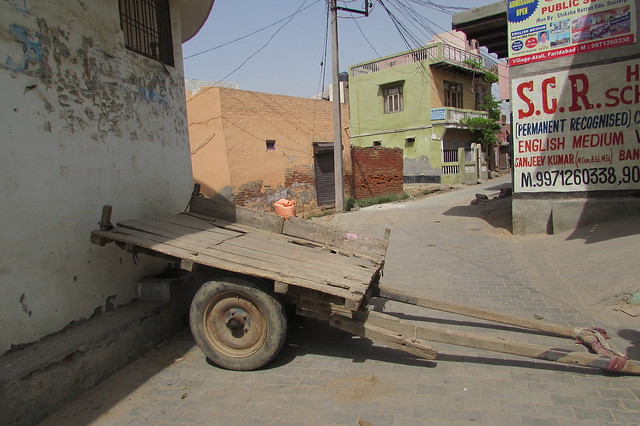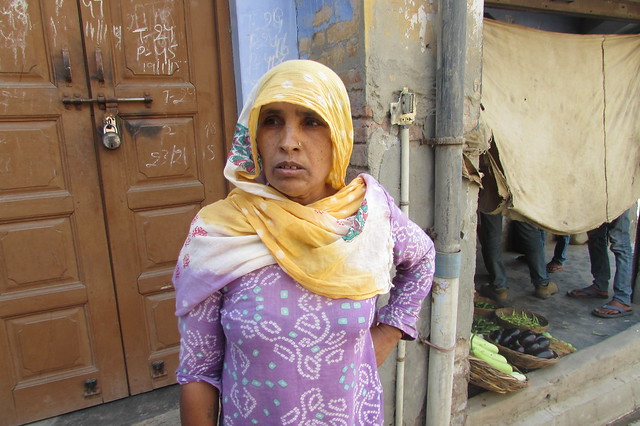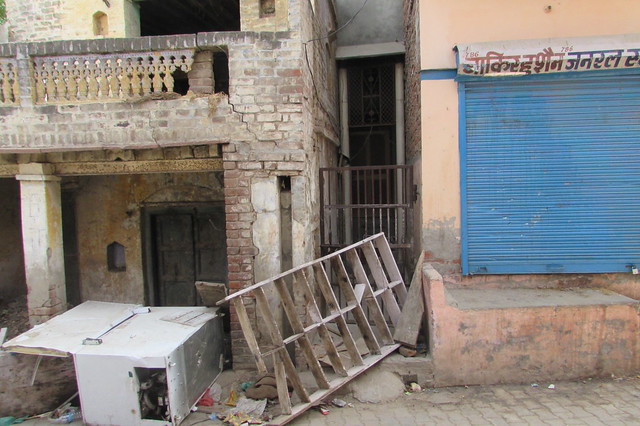A visit at the riot hit village exposes the deep communal divide and points to same pattern of communal riots, where issue of love Jihad to Ghar wapsi reverberate among Hindus.
By M Reyaz, TwoCircles.net,
Atali (Ballabgarg, Haryana): A week after the May 25 incident, when Hindus attacked Muslim homes in Atali village, about 12 kms from Ballabgarh tahsil in Faridabad district, the village wore a deserted look as this correspondent reached there on Sunday afternoon. There were RAF personnel sitting near the mosque site – the bone of contention – and at other critical junctions in the villagers. There were more RAF personnel than the villagers.
A visit to the riot hit Atali village exposes the deep communal divide that is fast engulfing large parts of rural northern India and aggravating several flash points. As we spoke to the villagers, we found same pattern of communal riots that has evolved in last few years, where issue of love Jihad to Ghar wapsi reverberated among Hindus. Like several communal tensions in recent months across western Uttar Pradesh, there was hardly any casualty except injuries to few, but the attackers largely targeted the houses and properties of minorities and in the process have left deep scars. Like Muzaffarnagar riots, this was largely a fight between Muslims, who come from Faqir or Qalandar communities, and Jats.
 Atali village on Sunday afternoon.
Atali village on Sunday afternoon.Villagers at first appeared unwilling to talk on the incident that has driven 500 Muslims from the village. They are camping at the Ballabgarh Police station for over a week now in the scorching heat. After some nudging, however, some of them opened up. At one corner of the village, some women and young men were sitting; they got agitated seeing people from the media. “Everyone is coming and probing as if we all are criminals,” says a middle-aged woman, in a rather agitated tone. As she and other people in the group continued to express their “angst,” we got a peek of what has been going underneath that is fast damaging the social fabric of the society.
 Three companies of RAF have been deployed in the village, besides large number of polie force, including several women perssonel.
Three companies of RAF have been deployed in the village, besides large number of polie force, including several women perssonel.“They are handful in numbers but want to dominate over us,” said one middle-aged woman, as several others echoed her sentiments. A young man sarcastically said, “This will become another Pakistan and we will be forced to convert to Islam if they are allowed to live here.”
When the first woman whined, “They harass our girls and elope with them”, an elderly woman confronted her saying: “If our girls themselves have gone astray, why blame them?” A middle aged man intervened to give example of how a Muslim boy had “ran away” last year with a one of “their” girls and lives in a nearby village. “To mock us now, he sends invitations to the village inviting people for the function of their new born,” he raged.
(When TCN inquired, it was found out that last year a Muslim boy named Naushad has indeed married a Hindu woman earlier divorced by her first husband, but the two families share cordial relations.)
 Atali village wore a deserted look on Sunday afternoon, a week after the communal incident.
Atali village wore a deserted look on Sunday afternoon, a week after the communal incident.Several theories: On what caused the immediate spark for the attack on May 25, several theories are doing the rounds in the village. While in most riots you see the villagers in denial, claiming that ‘people from outside were involved,” here most people did accept that villagers in large number gathered to “teach a lesson … as warning” to them.
Confusion over land ownership: While it is clear that the mosque site is a Waqf land and has been in use of the Muslim community for at least five decades – as also affirmed by different courts – the non-Muslim villagers reiterated that the land belongs to the Panchayat and blamed the current Sarpanch Rajesh Choudhary for “wrongly” allowing the Muslims to build the mosque there.
 Dayawati
Dayawati‘Muslims attacked first’: Some of the non-Muslim villagers also claimed that the villagers gathered to attack the Muslims in “retaliation” as Hindus were attacked first. They call a woman named Dayawati to reiterate their point. Dayawati shows the “wound” on her head as she says, “Some of us women were doing Kirtan in the local temple when they (Muslims) started pelting stones at us … if our men and boys had not immediately come out that day, we might even have been killed.”
Intended to be a mere warning: As the media team proceeded further looking for the house of the Sarpanch, who is now being seen as a “villain” of sort by most non-Muslim villagers, he was not to be found. He, along with some village elders, had gone to Ballabgarh Tehsil to negotiate peace for the village. A group of men, however, huddled not very far from the Sarpanch house. As we tried to initiate a conversation, they appeared reluctant initially, but gradually opened up. “The Sarpanch and village elders have gone to talk to them, let’s see what comes out,” said one, adding, “There is no point talking to us.”
As our conversation continued, a middle-aged man animatedly said, “It (attack of May 25) is not such a big issue, you people (media personnel) are raking it too much. It was a mere warning to them; the intention was not to kill them.”
In a rather intimidating tone, he added pointing towards us, “If we want we can cut your hand, but that is not our intention,” as others laughed and we too pretended to take it as a joke.

Issue raked for political exploitation: Whatever the issue was, the fact is that the damage has already been done as we noticed the deep communal divide. There was abusive language amply used for Muslims. If nothing, many see it as a preparation for the upcoming local elections and point out that even in 2010, the mosque issue was revived just before the Sarpanch election. The sarpanch elections are due later this year.
Silver lining: Amidst darkness, however, there is a glimmer of hope too in the whole Atali incident. As against in very few riots in the past, one noticed that within days “negotiations” began between two communities for “peaceful and amicable resolution” to the problem. It is reflective of the fact that all is not lost and there are people resisting the communal divide on both sides.
In fact, one of the first villagers who agreed to talk to us when we entered the village was Somesh Sharma, who runs a local grocery shop. In a very polite tone he shared with us what had happened that day, telling us how villagers gathered around 5.00 PM and seeing the large mob, he too had put the shutter of his shop down, fearing rampage.

Shops and properties of Muslims besides their houses have been damged and looted.
“We have lived here together and participate in each others’ functions and marriages. It is sad to see how deep communal divide is taking place,” he lamented.
Pointing to the shop opposite his, he said, “That shop is of Zakir Husain. I call him Khan Saheb. If I have to go for the call of the nature or any emergency, I would ask him to look after my shop and he would do the same (suggesting the trust they shared).” Sharma hoped that the villagers can come back soon and the issue is resolved amicably.
Related:


